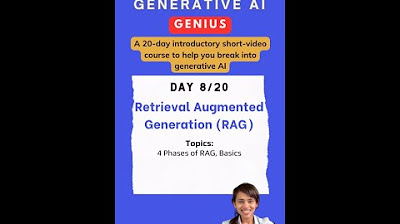RAG vs. CAG: Solving Knowledge Gaps in AI Models
Summary
TLDRThis video explains two advanced techniques to overcome knowledge limitations in large language models (LLMs): Retrieval-Augmented Generation (RAG) and Cache-Augmented Generation (CAG). RAG uses an external knowledge base to retrieve relevant information during query processing, making it modular and scalable for large, dynamic datasets. CAG, in contrast, preloads all knowledge into the model's context window, making it faster but limited by the model’s token capacity. The video compares these methods in terms of accuracy, latency, scalability, and data freshness, with examples demonstrating when to use each approach based on the knowledge base’s size and update frequency.
Takeaways
- 😀 Large language models (LLMs) face a knowledge problem when information is outside their training set.
- 😀 Retrieval-Augmented Generation (RAG) allows LLMs to query an external knowledge base to overcome knowledge gaps.
- 😀 RAG uses a two-phase system: an offline phase to index knowledge and an online phase to retrieve relevant documents for answering queries.
- 😀 Cache-Augmented Generation (CAG) is an alternative to RAG, where all knowledge is preloaded into the model's context window for fast access.
- 😀 With RAG, relevant document chunks are retrieved based on the user's query, providing context to the LLM for accurate answers.
- 😀 CAG stores a large amount of knowledge upfront in the model's context window, enabling faster responses but limiting scalability due to context window size.
- 😀 RAG ensures accuracy by relying on the retriever's ability to fetch relevant documents, while CAG depends on the model to extract information from a massive context.
- 😀 RAG introduces some latency due to the retrieval process, but CAG has lower latency as it eliminates the need for retrieval.
- 😀 RAG scales better with large datasets since only relevant chunks are retrieved for each query, while CAG is constrained by the model's context window size.
- 😀 RAG can easily update its knowledge base by indexing new information, whereas CAG requires reloading and recomputing the entire context if the knowledge changes.
Q & A
What is the main knowledge problem faced by large language models (LLMs)?
-LLMs struggle to recall information that was not included in their training set. This includes data that emerged after the model's training or proprietary information such as a client's purchase history.
How does Retrieval-Augmented Generation (RAG) work?
-RAG uses a two-phase system where an LLM first retrieves relevant documents from an external knowledge base. The retrieved documents are then passed along with the user query to the LLM, providing context to generate an informed answer.
What is the fundamental difference between RAG and CAG?
-RAG retrieves relevant information from an external knowledge base when needed, while CAG preloads the entire knowledge base into the model's context window for use in answering queries without the need for retrieval.
What does the KV cache represent in CAG?
-The KV cache, or key-value cache, is an internal state created from each self-attention layer in the LLM. It represents the model’s encoded form of all the knowledge documents, allowing the model to quickly access the information during query processing.
What is a key benefit of RAG's modularity?
-RAG is highly modular, meaning that you can swap out components such as the vector database, embedding model, or LLM without having to rebuild the entire system, offering great flexibility in implementation.
Which approach would be more effective for a small, static knowledge base like a product manual, RAG or CAG?
-CAG would be more effective because the knowledge base is small enough to fit within the model’s context window, and caching the entire set of documents would allow for faster responses compared to querying a vector database.
How does RAG handle large, dynamic knowledge bases?
-RAG is well-suited for large, dynamic knowledge bases because it can index millions of documents, retrieving only the most relevant pieces for each query without requiring the entire database to be loaded into memory.
What challenge does CAG face when dealing with frequently updated information?
-CAG struggles with frequently updated information because the entire knowledge base must be reloaded when the data changes, which can be inefficient and negate the benefits of caching.
Why might RAG be preferred for scenarios requiring precise citations?
-RAG excels in scenarios requiring precise citations because it retrieves specific, relevant documents from the knowledge base, making it easier to provide accurate references for the information used in the model's answers.
What hybrid approach might work well for a clinical decision support system?
-A hybrid approach combining RAG and CAG could work well in clinical decision support systems. RAG can retrieve specific patient data and research papers, while CAG can cache this information for follow-up queries, ensuring comprehensive and accurate responses.
Outlines

This section is available to paid users only. Please upgrade to access this part.
Upgrade NowMindmap

This section is available to paid users only. Please upgrade to access this part.
Upgrade NowKeywords

This section is available to paid users only. Please upgrade to access this part.
Upgrade NowHighlights

This section is available to paid users only. Please upgrade to access this part.
Upgrade NowTranscripts

This section is available to paid users only. Please upgrade to access this part.
Upgrade NowBrowse More Related Video

Introduction to Generative AI (Day 7/20) #largelanguagemodels #genai

RAG From Scratch: Part 1 (Overview)

Turn ANY Website into LLM Knowledge in SECONDS

What is Retrieval-Augmented Generation (RAG)?

[RAG Series #1] Hanya 10 menit paham bagaimana konsep dibalik Retrieval Augmented Generation (RAG)

Fine Tuning, RAG e Prompt Engineering: Qual é melhor? e Quando Usar?
5.0 / 5 (0 votes)